Goat Grazing Could Be Option for Invasive Species Removal
Wendy Mayer, Communications Coordinator
Prescribed or targeted grazing has been used on Western rangelands for many years to manage range weeds and is also used to reduce fuel and maintain fire breaks in high-fire hazard areas. It has also been used in the south to help control kudzu.
In a recent study, Purdue Extension forester Ron Rathfon tested goat grazing as a method to control a continuous stand of mature, dense multiflora rose in the understory of one of the timber stands at the Southern Indiana Purdue Agricultural Center (SIPAC). After the steep slope resisted a few rounds of prescribed fire and conventional methods like cutting and spraying were deemed impractical due to the terrain and the thick growth of thorny rose, Rathfon decided to give the animals a try at reducing the invasive species.
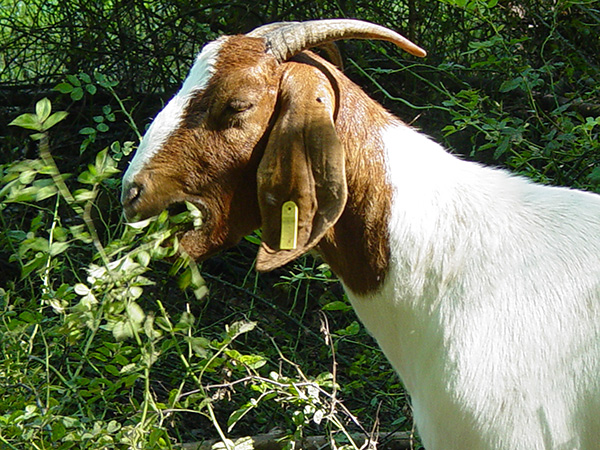 The results of Rathfon’s five-year experiment were recently published in the journal Restoration Ecology (Volume 29, Issue 4, May 2021) in an article titled “Effects of prescribed grazing by goats on non-native invasive shrubs and native plant species in a mixed hardwood forest.” Rathfon co-authored the publication with professor of forest ecology Dr. Mike Jenkins, and master’s degree alumna Skye Greenler.
The results of Rathfon’s five-year experiment were recently published in the journal Restoration Ecology (Volume 29, Issue 4, May 2021) in an article titled “Effects of prescribed grazing by goats on non-native invasive shrubs and native plant species in a mixed hardwood forest.” Rathfon co-authored the publication with professor of forest ecology Dr. Mike Jenkins, and master’s degree alumna Skye Greenler.
“Although prescribed grazing is not new, no research has been published demonstrating its use for invasive brush species management in eastern hardwood forests and quantifying its impacts on native vegetation,” Rathfon explained. “The goal was to test the use of the goats to control invasive woody brush species as a first step in restoring degraded hardwood forests. I anticipated the goats would reduce understory plant cover. What I didn’t know is how long it would take or whether native vegetation would be more severely impacted than the targeted invasive plants.”
Rathfon and his cohorts varied the goat stocking rate (16 vs. 32-48 goats per acre) and also the number of times a plot was grazed during a growing season (once or twice). Goats were not left in the woods continuously throughout the growing season. When they consumed all green leaves, they were removed, to prevent serious long-term damage to the trees, which had occurred with past livestock grazing in woodlands.
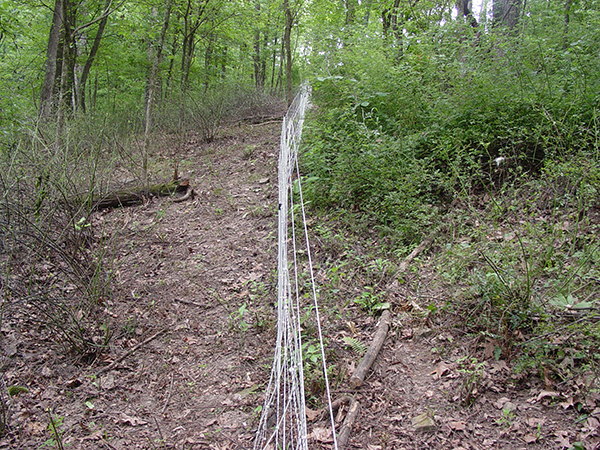 The results were an annual, incremental reduction of multiflora rose cover and an average reduction in cover of 40% across the four grazing treatments after five years of grazing. The timber stand started with between 60 and 70% cover of rose and ended up with 16 to 32% cover. The cover of native plants also was greatly reduced.
The results were an annual, incremental reduction of multiflora rose cover and an average reduction in cover of 40% across the four grazing treatments after five years of grazing. The timber stand started with between 60 and 70% cover of rose and ended up with 16 to 32% cover. The cover of native plants also was greatly reduced.
The experiment also shed light on the feeding preferences of the goats, which are considered generalists, meaning there are few plants they won’t eat. They do have their preferences and will first seek out those before feeding on less preferred plants. In the first year of the study, spicebush displayed the greatest decrease in cover of any species. The goats seemed to have preferred it and ate it first, and then moved on to consume the multiflora rose, even with its sharp thorns. Ultimately, however, they also ate most other native plants, with the exception of pawpaw, wild ginger, and twinleaf.
Even though most plants had their cover reduced by the grazing treatments, herbaceous plant diversity and species richness were not reduced, but remained steady or even increased in one of the grazing treatments. This means that native plant species persisted through grazing. In fact, with the reduction of the invasive multiflora rose, new growing space and reduced shading allowed new native plant species to grow in some places.
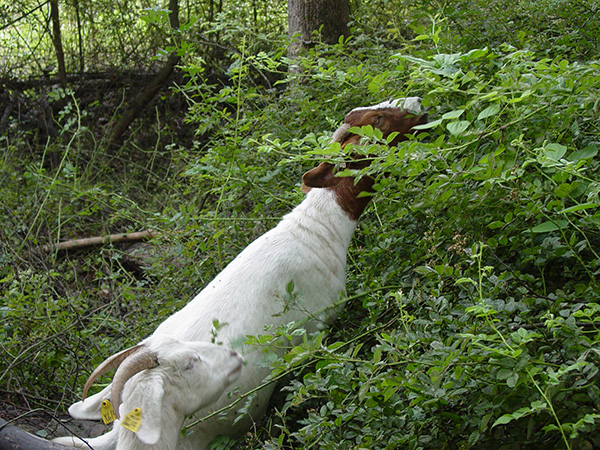 Following the five years of grazing with goats, Rathfon followed up with a targeted herbicide spray to kill what remained of the multiflora rose and other invasive plants. In the coming years, he will track the recovery of the forest understory plant community to see what grows back and how long it takes for native shrubs and tree seedlings to grow back.
Following the five years of grazing with goats, Rathfon followed up with a targeted herbicide spray to kill what remained of the multiflora rose and other invasive plants. In the coming years, he will track the recovery of the forest understory plant community to see what grows back and how long it takes for native shrubs and tree seedlings to grow back.
Rathfon hopes this experiment and publication illustrate the positive effects carefully managed prescribed grazing using domestic animals, particularly goats, can have on woodlands severely infested with invasive brush, offsetting mid-twentieth century research which documented the damage that could be caused by allowing livestock in the forest.
“In an age of an overwhelming tidal wave of invasive vegetation, prescribed grazing may make sense as another tool to consider,” Rathfon said. “In very heavily infested and/or degraded habitat and where very difficult terrain limits equipment options, prescribed grazing may be an option. It will not eradicate invasive plants, but, in combination with other treatments like cutting and herbicide application, it can be used to effectively treat certain infestations.”
“Over a period of days, you can watch a miraculous transformation taking place. Thanks to our little furry, cud-chewing friends, what was once a seemingly hopeless, dense, impenetrable tangle of nasty thorns, suddenly doesn’t seem as daunting a menace.”
Key practical implications from the publication state that:
- Although livestock grazing has historically degraded forest ecosystems, prescribed grazing by goats reduced the cover and height of aggressive non-native shrubs while having little effect on native herbaceous cover and diversity
- Because goats consumed both native and non-native woody species, initial treatment with prescribed grazing should be followed up with focused mechanical and/or chemical treatments to maintain invasive control while allowing the reestablishment of native woody species.
- Prescribed grazing is best applied in heavily invaded forests where initial control of invasive species must be achieved before subsequent restoration efforts can be initiated.
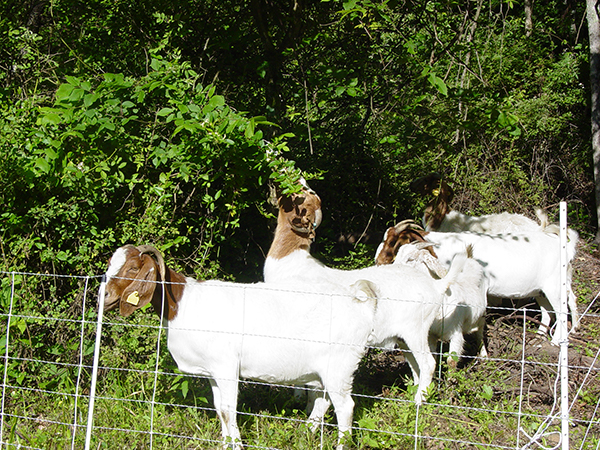 Rathfon notes that there is not currently a large herd-for-hire industry which makes it impractical for many natural resource professionals or landowners to utilize prescribed grazing at this time, but given the financial impact that invasive species can have, all options must be considered.
Rathfon notes that there is not currently a large herd-for-hire industry which makes it impractical for many natural resource professionals or landowners to utilize prescribed grazing at this time, but given the financial impact that invasive species can have, all options must be considered.
The cost of prescribed grazing is also a question for future research. While Rathfon benefitted from SIPAC’s on-site goat herd, along with the assistance of SIPAC manager Jason Tower and farmhands who helped manage the goats, goat herd rental estimates in the Midwest typically range from $600-800 an acre to $900-1300 an acre. These costs are within the ranges of first-time treatment costs using mechanical and herbicide treatments for modest to heavy infestations of invasive brush. Prescribed grazing may be chosen over conventional cutting and herbicide treatments because it is considered more environmentally friendly, however, it must be repeated over multiple years to have a significant and more lasting impact on the invasive vegetation.
In research not included in this publication, Rathfon compared prescribed grazing to a conventional control treatment, which used mechanical cutting and herbicide application. He found that herbicide treatments that followed prescribed grazing required 59 percent less herbicide volume as foliar spray and 61 percent less labor time to apply than conventional cutting and spraying treatment. This could be vital information as many natural resource managers aim to reduce chemical inputs to the environment.
Rathfon has spent the last two decades researching invasive species control and says prescribed grazing is just another treatment option to add to the toolkit.
“There are no silver bullets to controlling invasives, just many options to choose from,” he noted. “Effective management involves understanding the problem, assessing your resources and options and choosing the best combination of treatments (effective and cost efficient) to meet your management objectives. Prescribed grazing may just be one of those options to be used in combination with others to meet a very specific need. Perhaps this research may spark interest in some managers and landowners willing to take a risk on a new idea. It may also clarify or remove some uncertainty about the benefits and potential negative impacts of prescribed grazing.”
Next up for Rathfon on the prescribed grazing front is to secure an arrangement for renting goats for future seasons as SIPAC has downsized its herd. He then plans to test prescribed grazing at different times of year (from early spring to late spring, mid-summer and late summer) to see it has the greatest impact on target plants and native plants.
This research would allow him to test the theory that since most invasive brush species leaf out much earlier than native plants, grazing at that time when the new shoots would be tender and more completely consumed by the goats might be more effective than later in the year when the new shoot growth has hardened and is less palatable.
2012-2017 Progression
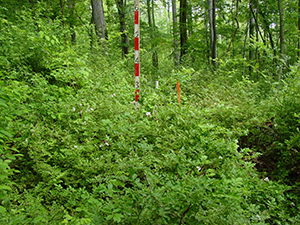 2012
2012 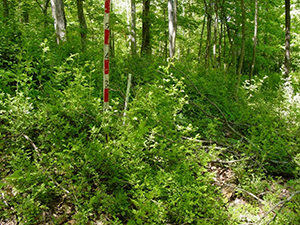 2013
2013  2014 plot.
2014 plot. 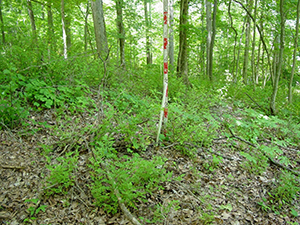 2015
2015 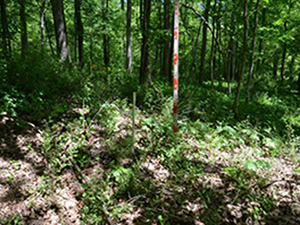 2016
2016 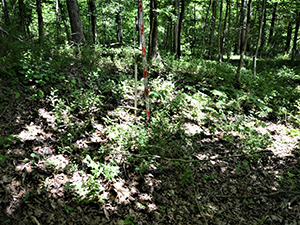 2017
2017 





